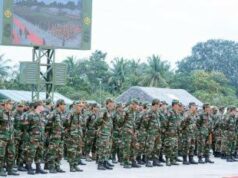US Intel report off the Mark

An assessment by US intelligence agencies is bit off the mark if Not way off, right from the start. It talks about a border between India and China, knowing fully well that China and India share no International Border.
It is Tibet which has International Borders with China, though, the said border was trespassed by PLA of Communist Party of China in mid 1950s and the Country captured by 1959.
Next China started salami slicing the Indian territory and by 1961 had quietly captured up to Aksai Chin area of India in Ladakh Sector. Then in 1962 it declared a full war and the present Line of Actual Control in Ladakh is the result of that war. China is even in occupation of Skashagam Valley bordering Gilgit Baltistan area.
However in 2020 India placed a full stop into the salami slicing tactics of China by giving a bloody nose to them at Galwan. Earlier in 2018, PLA was forced to back off at Doklam on Bhutan frontier and the PLAN dared not come near to Andaman Sea forget Maldives.
Now the US Intelligence warns of a “potential” armed conflict between India and China amid large troop deployments by both sides and sporadic encounters between their militaries, adding the dispute “will remain a strain” on ties between the neighbours. Well this is no revelation of Biblical nature.
Both Indian Army and PLA are evenly matched on the LAC in Ladakh Sector and across the Himalayas in Sikkim and Arunachal. For any misadventure PLA requires much more than 6 to 1 superiority, which it is sorely lacking.
In fact close look at things may indicate that Indian Forces may be having an edge too. Finally the Indian Navy is the ace up the sleeve, ever ready to cut the Jugular vein of the Dragon passing through the Shipping lanes of Indian Ocean Region.
The faulty assessment further states that China is looking to establish overseas military bases at multiple locations – including Sri Lanka and Pakistan – in its attempt to “project power” and “protect China’s interests abroad”.
Beyond developing its military base in Djibouti and its military facility at Ream Naval base in Cambodia, Beijing reportedly is considering pursuing military facilities in multiple locations, including—but not limited to—Burma, Cuba, Equatorial Guinea, Pakistan, Seychelles, Sri Lanka, Tajikistan, Tanzania, and the UAE,” it says.
Even USA should be knowing that berthing facilities for refuelling as per international norms and establishing military bases are two different things, poles apart.
The LAC dispute between India and China will remain a huge strain on their bilateral relationship. India has clearly told China that there will be no business as usual till the Indo Tibetan border is demarcated and also the Tibet China border.
The two sides have not engaged in any cross-border clashes since 2020. They are maintaining large troop deployments, so naturally risk of sporadic encounters between opposing forces because of miscalculation escalating into armed conflict will always exist.
However enough safety protocols are there by both sided to prevent this. So the annual threat assessment of the US intelligence community, released by the Director of National Intelligence (DNI) on Monday, as it talks about potential inter-state conflicts is a bit off the mark.
As usual the report highlights a fragile global order, China’s military expansion plans, its aggressive cyber operations and its possible attempt to influence the 2024 US presidential elections. It further talks about other conflicts including the Israel-Hamas war and the Russia-Ukraine conflict.
Prime Minister Narendra Modi last week inaugurated the strategic Sela tunnel, built at an altitude of 13,000 feet in Arunachal Pradesh, that will provide all-weather connectivity to Tawang.
Infrastructure projects near Indo-Tibet border have gathered pace since a military standoff with PLA in Ladakh sector of the Line of Actual Control (LAC) began in May 2020.
Both sides have arrayed close to 50,000 troops each in Ladakh sector and India has made it clear that bilateral relations cannot be normalised only after demarcation of respective borders.
The report also points to possible armed conflict between India and Pakistan as well in case of any provocations from Islamabad. “New Delhi and Islamabad are inclined to sustain the current fragile calm in their relationship following their renewal of a cease-fire along the Line of Control (LoC) in early 2021.
However, neither side has used this period of calm to rebuild their bilateral ties as each government has focused on more pressing domestic priorities including election perpetrations and campaigning and for Pakistan, concerns over rising militant attacks in its west,” the report underscores.
The USA Intelligence should be more worried about Pakistan’s long history of supporting anti-India terrorist groups and India’s patience running out along with its willingness, to respond with military force to perceived or real Pakistani provocations.
Time has come for finishing the left overs agenda of 1947 Partition that is taking back PoK and Gilgit Baltistan, if required by force. Also to help Baluchistan and Tibet regain their independence.
The report notes that Beijing will focus on building a fully modernized national defense and military force by 2035 and for the PLA to become a world-class military by 2049.
“In the meantime, the CCP (Chinese Communist Party) hopes to use the PLA to secure what it claims is its sovereign territory, to assert its pre-eminence in regional affairs, and to project power globally, particularly by being able to deter and counter an intervention by the United States in a cross-Strait conflict”, it adds.



